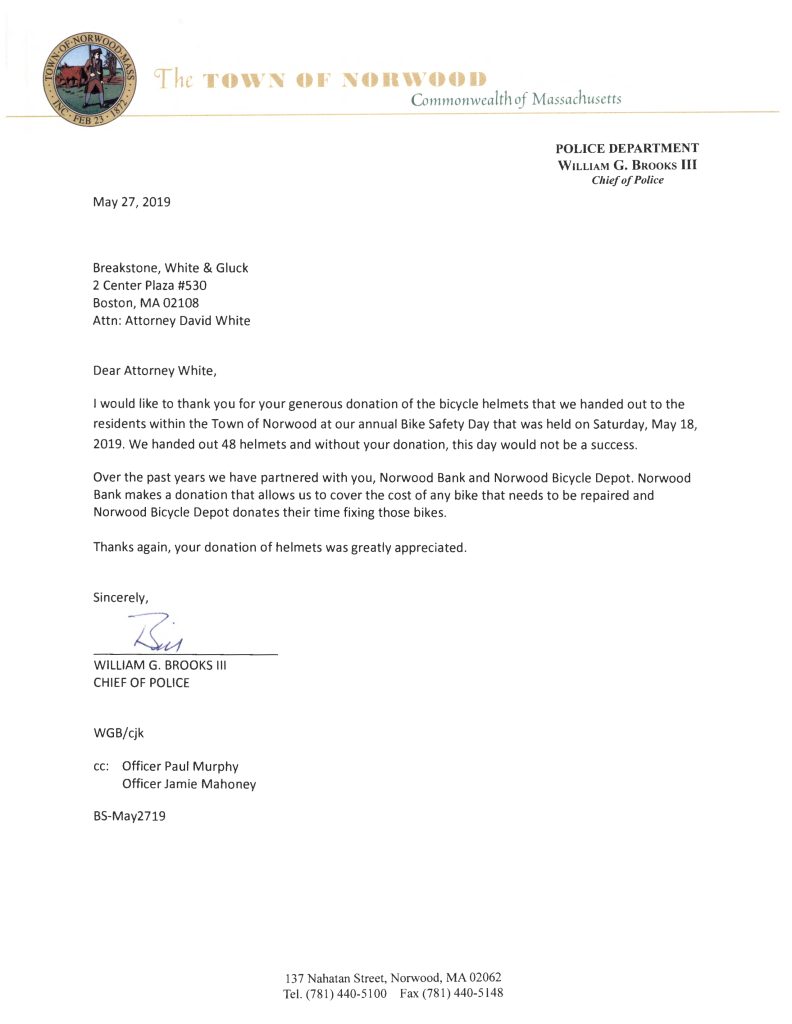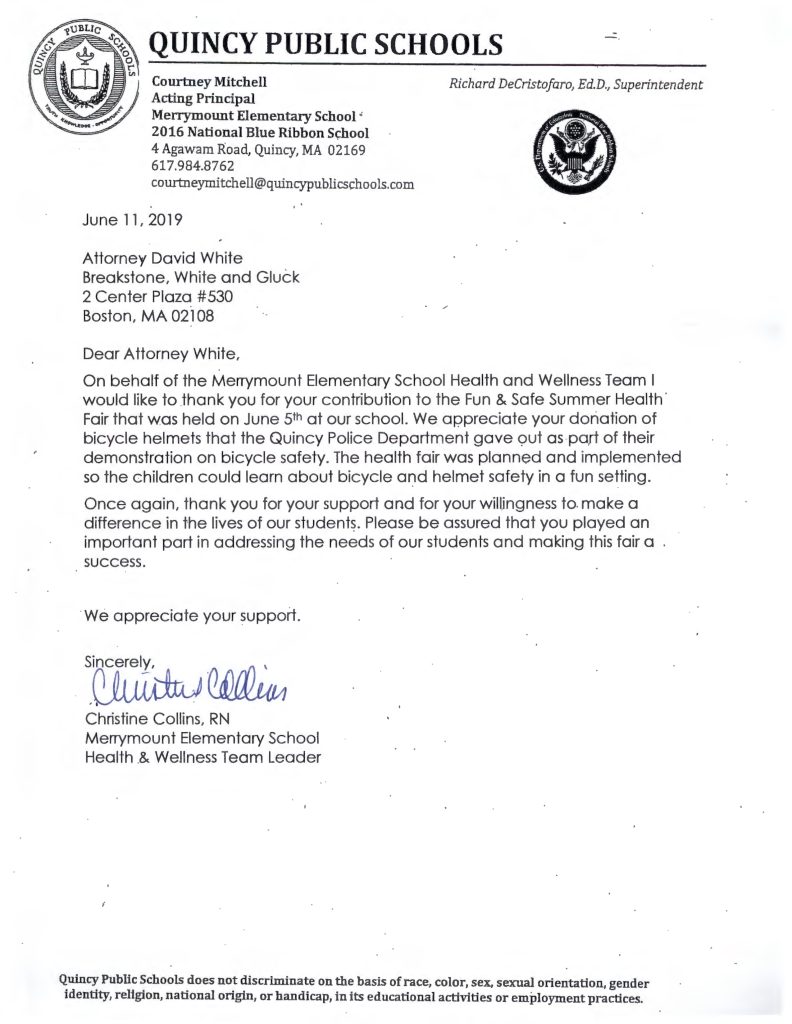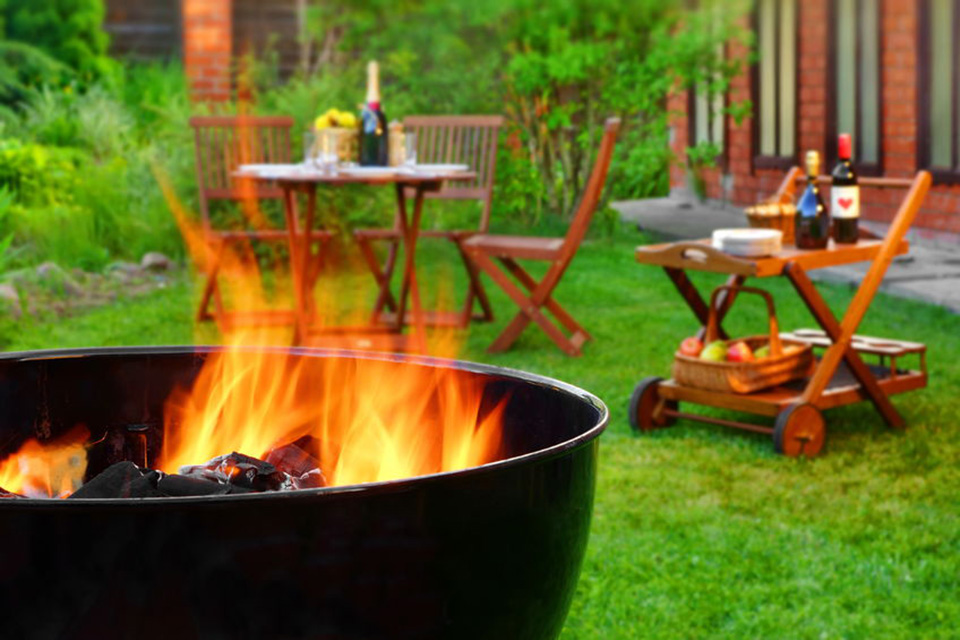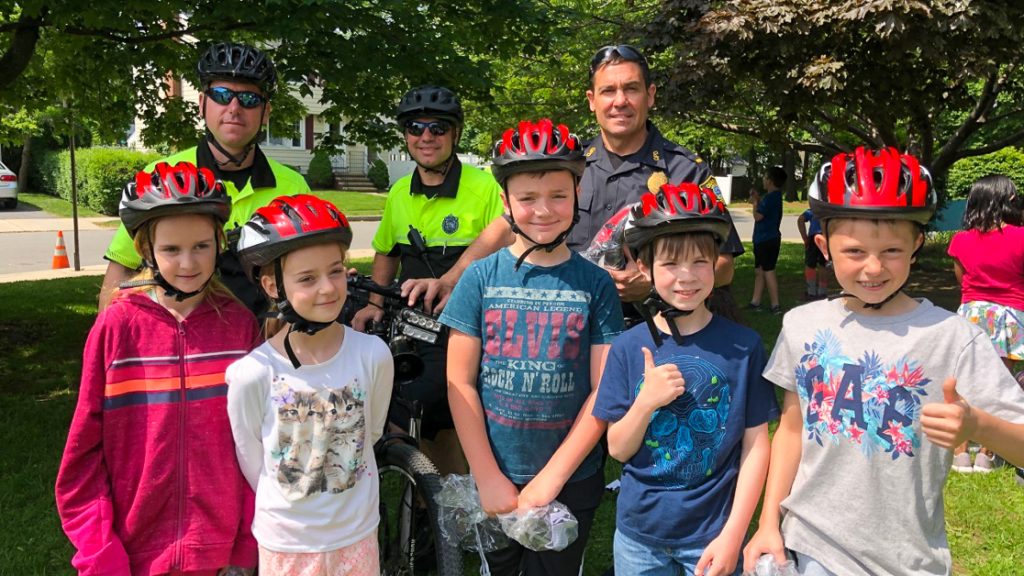Posts by Breakstone, White & Gluck
Attorney Marc L. Breakstone Tells Boston Globe: Kevin Spacey Civil Lawsuit is Over

Attorney Marc L. Breakstone was interviewed this past weekend about the civil and criminal cases against actor Kevin Spacey. Breakstone said the accuser’s decision to withdraw the civil lawsuit “with prejudice” is extremely significant.
“This will never be refiled,” Breakstone told The Boston Globe. “This claim is now extinguished for all time.”
The accuser, who is the son of former Boston television anchor Heather Unruh, just filed the civil lawsuit in Nantucket Superior Court on June 26. Breakstone said the withdrawal of the civil lawsuit could mean Spacey has reached a settlement with the accuser. If there is such an agreement, Breakstone said, there will likely be confidentially requirement to keep the details private and out of public view.
Spacey and his legal team are scheduled to return to Nantucket District Court this morning for a hearing in the criminal case. Breakstone said withdrawal of the civil lawsuit could jeopardize the criminal proceedings, but prosecutors interviewed by The Boston Globe insisted the civil case will not affect the criminal proceedings.
Kevin Spacey is a two-time Oscar winner best known for his role on “House of Cards,” a Netflix production. He played the character of Frank Underwood from 2013 through 2017, when he was charged with indecent assault and battery in Nantucket. Netflix kept producing the show, but cut ties with Spacey.
Spacey is accused of indecent assault and battery on Unruh’s son in July 2016 at Nantucket’s Club Car Restaurant.
About Breakstone, White & Gluck
The Boston personal injury lawyers at Breakstone, White & Gluck have over 100 years combined experience representing those injured by the negligence and wrongdoing of others. If you have been injured, learn your rights. For a free legal consultation, 800-379-1244 or 617-723-7676. You can also use our contact form.
Fourth of July Water Safety Tips

Tips for swimming safely in Massachusetts pools, lakes and ponds and ocean beaches.
We wish our friends, families and colleagues a wonderful Fourth of July holiday week. Whether you enjoy the fireworks in Boston or travel to Cape Cod, we hope you enjoy a more leisurely pace, some good BBQ and a little time in the water. But before you swim, we urge you to remember the rules of water safety at all times.
Ten people die in unintentional drownings each day in the U.S., according to the Centers for Disease Control and Prevention (CDC). While young children suffer a high number of drowning deaths, swimmers of all ages are at risk during the holiday week and summer months, when we spend more time near the water. This is partly because of our water skills – many of us can’t swim or we overestimate our abilities. According to the American Red Cross, 80 percent of Americans claim they can swim, but just 56 percent can actually perform the five basic water competency skills.
Alcohol consumption also tends to rise during celebrations and gatherings. Alcohol consumption can interfere with one’s ability to interpret their surroundings and respond in any setting, but especially in extreme heat. Near the water, alcohol is particularly potent, factoring into up to 70 percent of deaths associated with water recreation, according to the CDC.
Swimming Pool Safety
Pools should be protected by four-sided fencing which stands at least four feet tall. Doors should be self-closing and self-latching. If you are a parent, avoid visiting homes with inadequate fencing because this is the first and most important line of defense in protecting your child against drowning.
Pools should also have anti-entrapment drain covers and safety release systems to protect children from drain entrapment. Ask pool owners where the drains are before you swim.
Watch children closely. Commit to avoiding distractions such as cell phones, conversation or grilling.
In general, beware of any activity which encourages you to move your gaze up, down or away from the pool. If a child is struggling in the water, they need an immediate response and they cannot call out to you if they are starting to drown.
Never consume alcohol at the pool.
Swim with young children and keep them within arm’s reach.
When using an unfamiliar pool, take a test swim on your own without your child.
Walk into a pool using steps or a ladder, rather than diving.
When you are done swimming, if you have young children, leave the pool area and make sure it’s properly secured.
Water Safety in Lakes and Ponds
If you are swimming, look for a public or private beach staffed by lifeguards.
Adults and children should wear life jackets when in lakes and ponds, on a boat or a dock.
Do not consume alcohol at the lake or pond.
Always swim with a friend or family member.
Closely supervise young children to prevent drownings. At lakes and ponds, there are more elements to consider, including shifting sand and dark water.
Enter the water feet first from a beach or other areas marked as safe entrances.
Only dive in areas which are clearly marked as safe for diving. Jumping in feet first is safer.
Never dive from bridges or boats.
Be responsive to water and weather conditions. Leave the water immediately when there is thunder and lightning.
Pay attention to boats, personal watercraft and other swimmers on the pond which could interfere with your ability to swim safely.
Water Safety at the Ocean
Do not expect your family to be ready for the beach just because they have experience in a swimming pool or even a lake or pond. The ocean is much more challenging and unpredictable.
Choose beaches staffed by lifeguards. In addition to responding to emergencies, lifeguards can share information about water conditions, such as the tide schedule, vegetation, marine animals and fish.
Just like every lake and pond, remember every beach has different conditions.
Swim with young children.
Never swim alone; swim with a buddy.
Learn how to identify a rip tide and how to respond. According to the American Red Cross, swimmers are advised to swim parallel to the shore line until they are free from the rip tide. When swimmers can’t do this, they can attempt to just float and tread water until they have moved out of the rip tide.
Leave the water immediately if you hear thunder or see lighting. You should also head back to shore if you are traveling in a boat. If you can’t return to shore, lie in the bottom of the boat or shelter in the cabin if you can.
About Breakstone, White & Gluck
The Boston personal injury lawyers at Breakstone, White & Gluck are committed to providing clients with aggressive and thorough representation. We represent clients in all types of personal injury cases, including car accidents, bicycle accidents, pedestrian accidents, dog bites, swimming pool injuries and premises liability cases. For a free legal consultation, contact us today at 800-379-1244 or 617-723-7676 or use our contact form.
Thank You Notes from Our Project KidSafe Campaign
Motorcyclists Face High Risks for Injury and Death in Truck Crashes
It was painful to learn of the New Hampshire truck crash which killed seven motorcyclists and injured three others last weekend. That one crash could injure so many is heart-breaking and we send our deepest condolences to the families.
The horrific accident happened Friday night in the community of Randolph, New Hampshire. The motorcyclists belonged to the Jarheads MC, a motorcycle club for Marine Corps veterans and close friends, according to The Boston Globe. The group was reportedly traveling to their annual meeting eastbound on Route 2 when they were struck by the truck traveling west. Reports said the truck crossed the double yellow line.
By Monday, the driver – a 23-year-old Springfield, Mass. man – had been charged with seven counts of negligent homicide in the case. Massachusetts State Police took Volodoymyr Zhukovskyy into custody at his home. He was then taken to Springfield District Court, where he waived extradition to New Hampshire.
New Hampshire authorities are still investigating the cause of the crash, but there are questions about whether Zhukovskyy should have been driving at all following his arrests on OUI charges last month and back in 2013, according to news reports. Meanwhile, his employer, Springfield-based Westport Transport is said to be cooperating with police.
While this type of collision causing so many injuries is rare, motorcycle crashes are not, especially during the summer in New England. Per mile, motorcyclists are 28 times more likely than passenger car occupants to die in a crash, according to the Insurance Information Institute. In fact, Massachusetts authorities report they have responded to four fatal motorcycle crashes between Saturday night and Monday morning.
Some of the crashes involved a single motorcyclist. This was the case in New Bedford, Belchertown and Andover. But in Westport, a preliminary investigation shows the motorcyclist was traveling westbound on Route 177 when there was a collision with a Ford Ranger turning onto Tickle Road. The driver of the Ford Ranger stayed on the scene and was said to be cooperating with police.
In addition to local authorities, motorcycle accidents should be investigated by an experienced motorcycle crash attorney. In some cases, another driver may not appear to be involved. But drivers who speed, stop short, pass a motorcycle illegally or fail to check their blindspot cause motorcyclists to crash all the time. These are known as no-contact crashes.
When trucks hit motorcyclists, injuries can be more severe as we saw in New Hampshire. Truck companies have a responsibility to train drivers how to operate near motorcyclists. Truck drivers must also take care to properly load vehicles, especially if they are carrying equipment and materials on open open trailers.
At Breakstone, White & Gluck, we urge drivers to observe the following:
- Motorcyclists have the right to operate on the same roads as drivers and must follow the same traffic laws and signals.
- Provide motorcyclists room. Travel several car lengths behind motorcyclists.
- Motorcyclists are permitted to ride two abreast in a lane in Massachusetts and New Hampshire. (Source: The Massachusetts Motorcycle Manual and AmericanMotorcyclist.com).
- Motorcyclist are not permitted to travel between traffic lanes (or split lanes).
- Accidents can happen when drivers fail to look before they turn. In fact, this was the cause of 44 percent of all motorcycle crashes in 2013, according to esurance.com.
- Attempt to make eye contact with motorcyclists at intersections. Many motorcyclists do not have self-canceling turn signals like car and you cannot trust a motorcyclist will turn until you see it.
- Check your mirrors and blindspots often.
- Some drivers have trouble driving in the rain. Expect the same from motorcyclists. Be patient and give them more room.
- Do not speed through traffic lights or make quick unexpected movements at traffic lights and intersections.
- Do not speed on any roads.
- Do not overload trucks and trailers. Secure equipment and materials behind a closed door or under secure ratchet straps, bungee tarp straps or other appropriate equipment.
- Do not attempt to pass motorcyclists unless you must. While you are allowed to do so in Massachusetts, the motorcyclist may not be expecting the move and surprises can lead to accidents and falls.
- Never drive when you are tired; do not drive when you are normally sleeping or getting ready for bed.
- Never drink and drive.
- Remove all distractions from your car, including cell phones. Hold heavy conversation and limit snacks and drinks.
Massachusetts Motorcycle Safety Tips
If you are a motorcyclist, please read our past blog, “Massachusetts Motorcycle Safety Tips.” The article can be a resource if you are just starting to ride, looking to become licensed or have questions about your Massachusetts auto insurance policy.
About Breakstone, White & Gluck
The Boston car accident lawyers at Breakstone, White & Gluck specialize in representing those injured in motorcycle accidents caused by the negligence of other drivers. If you or a loved one has been injured, learn your legal rights for seeking compensation. For a free legal consultation, contact us at 800-379-1244 or 617-723-7676 or use our contact form.
Grilling Safety at Summer Picnics and BBQs in Massachusetts

The first rule of grill safety: never leave your BBQ unattended.
As we approach the Fourth of July, many of us have grilling on our minds, and all the delights of summer BBQs. If you plan to grill, we hope you enjoy, but please remember to follow the rules of safety at all times.
This is the time to plan, because as we enjoy friends and family, July is the peak month for grill fires, the weeks when nearly 20 percent of all grill fires across the U.S. happen, according to the National Fire Protection Association (NFPA). August is another high risk month, accounting for 12 percent of grill fires.
Though these fires are devastating and life-changing events, they don’t always make the news. But according to the Massachusetts State Fire Marshal’s office, there were 474 fires involving grills, hibachis and barbecues between 2014 and 2018. Nineteen civilians were injured and seven firefighters were hurt in the wreckage. Property damage totaled $3.8 million in losses.
Across the 50 states, firefighters responded to 10,200 home fires involving grills, hibachis and barbecues each year from 2013 to 2017. Ten civilians were killed and 160 were injured. Property damage resulted in $123 million in losses.
Grilling Safety Tips
Compiled From the Massachusetts State Fire Marshal’s Office and Other Sources
- Only use propane and charcoal grills outdoors.
- Never leave your grill unattended.
- Keep a fire extinguisher nearby.
- Grills should be set up at least 10 feet away from the house or deck railings.
- Gas grills can be used on first-floor decks and patios, but they must be located on the ground level or have an outdoor stairway leading to the ground.
- Grills should never be set up under a roof overhang or low-hanging tree branches.
- Grills should not be used on fire escapes.
- Take additional precautions around children. Keep matches and lighters out of their reach. Create a circle of safety, keeping children and pets at least three feet away (more space is better).
- Do your grilling at least three feet away from tables and furniture. Fold grill covers and remove them from the cooking area.
Safe Handling of Propane Tanks
- Never smoke while handling or cooking with a propane cylinder.
- Keep propane tanks outdoors at all times, at least 10 feet distance from doors and other building openings. This includes windows and dryer vents.
- Keep propane tanks at least 20 feet from air intake vents and ignition sources.
- Propane cylinders should be stored outdoors in shady areas. Cylinders should not be used or kept in high temperatures.
- Replace propane cylinders that are aging, rusting or showing other wear and tear.
Charcoal Grills
- As with other grills, only use charcoal grills outdoors.
- When using charcoal grills, only use charcoal starter fluid. Never use gasoline or kerosene.
- Never add lighter fluid to hot coals. This can cause a flash fire, causing serious skin burns.
- Use charcoal grills in open outdoor decks and patios, just as you would gas grills. Be aware that charcoal briquettes emit carbon monoxide, a clear, odor-free gas which can accumulate in spaces and be deadly. Charcoal grills should never be placed in close quarters near an open window.
- Allow the grill to cool. After 48 hours pass, you can safely dispose of coals.
- If you cannot wait 48 hours, soak the coals in water, then place them in a metal container.
Maintaining Grills
- Review the product manual and instructions that come with your grill.
- Start by opening your grill to see if there is any animal activity or unexpected conditions.
- Next, check that your propane tank is safe for use. Dab soapy water on your propane tank and turn it on for a moment. If there is bubbling, you may have a potential leak. This should be done carefully. Before you try, watch a National Fire Protection Association video.
- Check that connections are tight before you turn the gas on.
- Clean the grease trap every time you grill.
Rooftop Grilling
Rooftop grilling is against the law in Massachusetts. When someone tries to grill on a rooftop, the damage can be deadly and exponential. Some may still remember the 2010 gas grill fire explosion that exploded and lit up the sky over Charlestown. Starting the fire was an illegal propane tank which exploded on a residential building’s rooftop. Soon after, three other illegal gas tanks burst nearby, igniting a 4-alarm blaze which move through several buildings.
Firefighters – 125 in all – battled the fire on a 100-degree Boston day. Nine firefighters and two civilians were treated for heat exhaustion injuries.
Maintain Safe Decks and Porches
Grill fires can happen when someone makes a mistake while cooking, when a child gets too close to the grill or if the grill has a product defect. Landlords may be held responsible in certain grill fires if they keep a defective grill or fail to meet building codes and illegally close off access ways. In Massachusetts, most residential properties are also required to have working smoke alarms on each floor of floor, including inside bedrooms and other areas. They must also have working carbon monoxide detectors.
You cannot always prevent negligence in these situations. But you may be able to minimize many injuries by providing yourself a little more room to work and taking it slow. Keep the grill area and walkways leading there open and clear. When you take grill covers off, set them in safe areas away from the grill. Finally, tell everyone in your home you are grilling and ask another adult to watch children.
Sources for this blog include:
Grilling Safety, Mass.gov
Getting Fired Up for Grilling Safety, Massachusetts State Fire Marshal’s Office
National Fire Protection Association
About Breakstone, White & Gluck
Breakstone, White & Gluck is a Boston personal injury law firm with expertise in premises liability and product liability cases. With more than 100 years combined experience, our attorneys have been recognized as top-rated personal injury lawyers in Massachusetts. Through our Project KidSafe campaign, we also work to bring safety information to individuals and families to help them make safe choices.
If you have been seriously injured by the negligence of someone else, learn your legal rights for seeking compensation. For a free legal consultation, contact us at 800-379-1244 or 617-723-7676 or use our contact form.
Beware of Tick Bites This Summer

Usually we post blog entries about preventing accidents and safety issues. But here is something that is a serious matter of public health, and we want you to protect yourself!
The incidence of tick-borne illnesses is rising sharply in Massachusetts, in New England, and throughout the country. If not diagnosed and treated promptly, infections can lead to disabling injuries, brain damage, organ failure, and even death. Prompt diagnosis is key, but even more important: Avoiding tick bites.
Understanding tick behavior is the first line of defense. Ticks are active throughout the warm weather months, but even a warm day in February can bring them out. They are most likely to transmit disease in the spring and early summer when they are in their nymph stage (when they are young and smaller). Ticks lurk in leaf litter, tall grass, and on shrubbery, just waiting to hitch a ride on your skin and clothing. Then they wander around until they find a place to bite. They will attach themselves and suck your blood until they are fully engorged. And if they are carrying one of the many bacteria that can make you ill, it will be transmitted during this time.
There are several ways to protect yourself, including wearing insect repellent or clothing treated with permethrin, an effective insecticide that is safe to use. Prevent ticks from getting on your skin by wearing long pants and long shirts, and stay tucked in. Check for ticks after you have been outside. More on this below.
Tick Diseases are on the Rise
It’s unfortunate that we have to think about protecting against ticks. But it’s also necessary. Each summer brings more and more reports of tick-borne illnesses in Massachusetts and across the U.S. According to the Centers for Disease Control and Prevention (CDC), 59,000 tick-borne diseases were reported during 2017 alone, more than 10,000 cases over 2016. More than 42,000 cases were Lyme Disease. According to the CDC, the number of U.S. counties considered at high-risk for Lyme Disease increased by more than 300 percent between 1992 and 2012.
Lyme Disease and Other Tick Diseases in Massachusetts
In Massachusetts, several types of ticks are known to spread infection. These include the black-legged tick, most often known as the deer tick, the dog tick and the lone star tick (Source: Mass.gov).
Black-legged ticks can transmit Lyme disease, anaplasmosis (HGA), babesiosis and other tick-borne illnesses. These are all very serious illnesses which can leave an otherwise healthy person with chronic pain, an irregular heart rhythm and other symptoms. Some of these illnesses can even lead to death.
While we associate ticks with warm weather, black-legged ticks can bite year-round in Massachusetts. The young ticks (called nymphs) are most active during May, June and July. Adult ticks become more active during the spring and fall, but can bite anytime the temperature is above freezing. It’s easy to mistake nymphs for other insects because they are small, about the size of a poppy seed.

Black-legged tick by size. Graphic courtesy: CDC.
When black-legged ticks infect someone with Lyme Disease, the person may suffer fever, chills, headache, fatigue, muscles and joint pain and swollen lymph nodes. About 4 out of 5 people will break out in a rash which is often a bullseye in appearance. In some cases, more serious symptoms emerge, including arthritis, heart palpitations, joint pain, nerve pain and problems with short-term memory.
Adult dog ticks are roughly the size of a watermelon seed and can spread Rocky Mountain spotted fever, which can lead to fever, headache, vomiting and rash in the first 3 to 5 days. Rocky Mountain spotted fever can result in death if left untreated.
Though it’s relatively rare in Massachusetts, dog ticks can also pass on certain types of tularemia, which results in skin sores and swollen glands. As for lone star ticks, it is important to guard against them because they can also cause rash, tularemia and southern tick-associated rash illness (STARI). But lone star ticks are not a significant source of human illness in Massachusetts at this time, according to the state website.

The the greatest risk for tick bites is in late spring and summer. Graphic courtesy: CDC.
How to Protect Your Family
The best ways to protect yourself from tick bites and tick-borne illnesses is to be aware of potential exposure in the deep woods and tall grass, wear the right insect repellent and continuously check your skin throughout the day and at the end of the day.
Insect Repellent
- Use EPA-registered insect repellents which contain DEET, picaridin, IR3535, oil of lemon eucalyptus (OLE), para-menthane-diol, or 2-undecanone. Use these products as instructed.
- Use insect repellent products with permethrin to treat clothing, socks, boots and tents. You can also look for products which have been pre-treated with permethrin. Follow the instructions for application carefully. Permethrin is applied to clothing, then allowed to fully dry. It is not meant to be sprayed on just before use. Treated clothing is effective for several washings. The good news is that the ticks that do climb on your treated clothing will die.
- Take extra caution when shopping for insect repellent products for children and those with medical conditions. Again, read product instructions.
- Children younger than 2 months old should never use products containing DEET. The CDC recommends putting babies in strollers covered in mosquito netting.
Understand How Ticks Infect
Ticks can contract bloodborne infections such as Lyme Disease by feeding on infected animals, especially white-footed mice. Then they carry these infections into your backyard and wait for their next prey. This could be you, your children, your guests or your pets.
Unlike other insects, ticks cannot fly or jump. They latch onto tall grass with their back legs, ready to climb on you when you pass by. This is called “questing.”
A black-legged tick can attach to your skin and feed on your blood for several days. Once the tick is done feeding, it will remove itself and find another person or animal to bite.
Avoid tall grass and shrubs, as well as the outer edge of your backyard. Ticks often camp out along well-traveled paths on your property, including near stony landscaping. Wherever you walk or hike this summer, walk in the center of the path.
The sooner you see a tick on your body and remove it, the better. According to the CDC, people who remove ticks within 24 hours can greatly reduce their risk of getting Lyme Disease.
Pets
Cats and dogs can bring ticks into your home. Talk to your veterinarian about how to protect your pets during the summer months. There is no evidence showing your pet can pass Lyme Disease onto you, but if your pet is bitten, they could suffer symptoms and you could be bitten as well. Since ticks can be carried into your home, be aware of exposure in your house.
Dressing Safely for the Outdoors
- Dress appropriately. Wear long-sleeves and pants when working in wooded areas. Tuck shirts into pants and pants into boots.
- Consider wearing white and other light colors if it helps you check for ticks easier.
- Another tip is you can use a lint roller on your clothes and shoes before you come inside.
- Take a shower as soon as you come inside. Rinsing ticks off before they bite is very effective.
- Toss your clothes in the dryer on high heat for 10 minutes to kill ticks.
Checking for Ticks and Extra Precautions
- Conduct a full-body tick check once or more daily. Use a hand-held or full-length mirror so you can check your back and other areas of your body. Check along your hairline, inside and behind your ears, the back of your neck, all over your arms and armpits, legs, behind your knees and even between your toes.
- Parents should check children thoroughly for ticks every few hours. Teach children to regularly check their own arms and legs as they play.
- Look closely and remember, ticks are different sizes.
- If you see a tick, carefully remove it from your skin with a pair of tweezers. Pull it out with a steady hand so you remove it all at once. Then clean your skin with rubbing alcohol or soap and water.
- You should dispose of a tick just as you would anything else that’s poisonous. Place it in a sealed plastic bag or flush it down the toilet. If you are concerned that the tick was on you long enough to bite, you can seal the tick in a plastic bag for later testing.
Visit Your Physician and Get Prompt Treatment
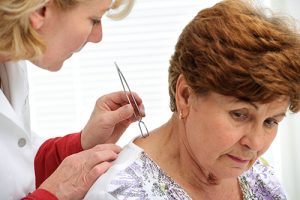
Massachusetts residents should visit their doctor if they suffer a tick bite.
There is a high risk for Lyme Disease in Massachusetts and other New England states. If you, your child or another family member were bitten by a tick, contact your physician immediately. Even if you don’t believe you are experiencing any symptoms, this is an important call to make. Your physician is knowledgeable about your medical background and the medications you are on and is in the best position to help you understand if you may need to take an antibiotic. If exposure to Lyme disease is considered a probability, your physician will likely prescribe a single dose of doxycycline as a prophylactic measure. It is very important to monitor yourself for symptoms of potential infection, including rash, headache, muscle or joint ache, or fever. If you are suspicious, seek prompt treatment to avoid more serious complications.
Use Reasonable Care and Good Sense
Don’t let the fear of ticks or other insects ruin a perfectly good summer. Use reasonable care and good sense, and you and your family should enjoy great outdoor fun.
MBTA Derailments Cause Boston Commuters Injuries, Stress and Delays

The MBTA saw 43 train derailments over five years, many Green Line trolley derailments. (File photo: bwglaw.com)
Two MBTA subway derailments have injured over a dozen and shaken hundreds of Boston commuters over the past week. At least 12 of the injured passengers were transported to local hospitals. You are not alone if you are watching and wondering if Boston’s subways are safe for use.
According to news reports, the first derailment happened over the weekend (June 9, 2019), when a Green Line trolley derailed in a tunnel near Kenmore Square. This accident happened about 11 a.m. Police and firefighters aided 150 passengers off the derailed trolley and out of the dark tunnel. Another 500 startled passengers were evacuated from other trolleys along the Green Line. Eleven people were injured, with 10 people sent to local hospitals. The Green Line trolley operator was among those injured.
Soon after, The Boston Globe reported the train derailment was not due to aging infrastructure or equipment, but was “operator-related.” The MBTA suspended the 62-year-old operator pending the outcome of the investigation.
WHDH reported the operator had three years of experience operating trains. Meanwhile, The Boston Globe reported the train derailed after the outbound D Line train left Kenmore Square. The trolley operator approached a signal marking where the D and C lines split (near Beacon Street and Commonwealth Avenue). He kept traveling over a switch that was in the process of switching between the lines.
Then Tuesday morning (June 11, 2019), a Red Line train derailed near the UMass Boston campus and the John F. Kennedy presidential library. About 60 passengers were evacuated. Despite the terrifying scene, just two people were treated for injuries. One was treated for a hand injury at the scene. Another person initially left the crash scene, then returned, asking to be transported to a hospital for neck pain.
Crews were still working to repair the Red Line damage Wednesday, leaving hundreds of commuters without their usual way into Boston. The Red Line provides services through Quincy, downtown Boston and Cambridge. The line ends at Alewife station.
The 39-year-old operator has been taken off duty pending the outcome of the investigation, according to WHDH.
According to MBTA ridership figures, the red line carried 272,000 people daily in 2013. This makes it the busiest subway line. The Green Line was second, with 227,000 passengers. The Green Line and the Mattapan Line are the only light-rail trolley systems.
Unfortunately, MBTA train derailments are more common than the public may realize. The Boston Globe reports MBTA trains have derailed 43 times over the past five years. This is the second-worst safety record in the U.S.
Train derailments must be thoroughly investigated by an experienced lawyer. Causes can include operator error, cell phone use, texting or speeding. Aging infrastructure and equipment failure are other potential causes.
If You Were Injured in a MBTA Train Derailment
If you were injured, it is in your best interest to receive a medical evaluation from a hospital or your physician. Then consult an experienced MBTA accident lawyer and learn your legal rights.
With more than 100 years combined experience, Breakstone, White & Gluck is experienced in representing individuals who have been injured by the MBTA. Our attorneys have investigated and represented clients injured by Green Line trolley collisions, MBTA bus crashes and other accidents. We have also represented families who have lost loved ones in MBTA accidents.
For a free legal consultation, contact Breakstone, White & Gluck at 800-379-1244 or 617-723-7676. You can also use our contact form.
Breakstone, White & Gluck and Quincy Police Give Away 100 Free Bicycle Helmets to Students at Merrymount School
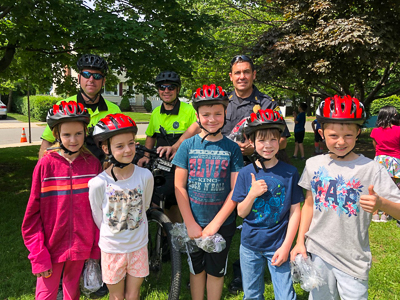 Quincy Police officers visited Merrymount School last week, speaking to children about bicycle safety in the city, and making the critical commitment to wear a bicycle helmet every time they ride. Quincy police officers talked to students at all grade levels, then gave away 100 bicycle helmets donated by Breakstone, White & Gluck’s Project KidSafe campaign.
Quincy Police officers visited Merrymount School last week, speaking to children about bicycle safety in the city, and making the critical commitment to wear a bicycle helmet every time they ride. Quincy police officers talked to students at all grade levels, then gave away 100 bicycle helmets donated by Breakstone, White & Gluck’s Project KidSafe campaign.
We are pleased to make this donation just in time for summer. This is the third year Breakstone, White & Gluck has partnered with the Quincy Police Department to encourage children and families to wear bicycle helmets to protect against head injuries. Breakstone, White & Gluck founded our Project KidSafe campaign in 2013, with a goal of helping children ride safely. Our attorneys have since given away more than 25,000 bicycle helmets to help children in the Boston area and across Massachusetts.
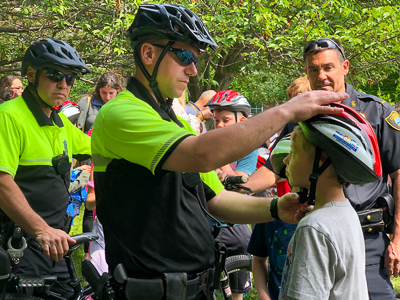


Photos are courtesy of the Quincy Police Department.
Safety Reminders to Protect Children from Swimming Pool Drownings
 Each year, families head into summer, hoping for fun in Massachusetts. No one expects tragedy in the backyard swimming pool. But each year, children suffer drownings and near drownings. Drowning is a leading cause of death among young children in Massachusetts and across the U.S. Young children ages 1 to 4 face the highest risk, followed by older children and teens between the ages 10 and 19, according to the American Academy of Pediatrics (AAP).
Each year, families head into summer, hoping for fun in Massachusetts. No one expects tragedy in the backyard swimming pool. But each year, children suffer drownings and near drownings. Drowning is a leading cause of death among young children in Massachusetts and across the U.S. Young children ages 1 to 4 face the highest risk, followed by older children and teens between the ages 10 and 19, according to the American Academy of Pediatrics (AAP).
Breakstone, White & Gluck, a Boston personal injury law firm, encourages parents and property owners to prepare for the swim season. By acting now, before the temperature rises, property owners and parents can minimize the risk of drowning and injury this summer.
For Pool Owners
Secure Pool Fencing
Pool owners have a responsibility to secure their pools with a strong durable fence. This is your legal responsibility and one of the most important steps you can take to prevent a child from a swimming pool drowning. The Consumer Product Safety Commission recommends pool owners install a four-sided fence with a self-closing latch around all pools and spas. The fence must be at least 4 feet tall in Massachusetts and must meet certain requirements for vertical clearance and width for fence openings. Read our past blog on pool fencing or check out this guide on a local community’s website.
If you own a pool, consider adding some additional fencing, shrubs or a planter – or several blocking access to your pool door and fence. This is called a “layers of protection” strategy and the goal is to slow children down so an adult can intervene.
Inspect Your Pool Regularly
Make it a habit to walk outside and inspect your pool daily during the summer months.
Pool Alarms
Consider purchasing a pool alarm to monitor your pool area. There are different types of alarms so do your research and select the best for your needs. But remember, a pool alarm is a supplement to your strong fencing and regularly inspecting your pool.
Drains
Pool owners should regularly maintain drain systems and ensure they work properly. Spas should be covered and locked when out of use. Children should never wear loose accessories into the pool.
For Parents
Swimming Lessons
Parents who sign children up for swim lessons give them an advantage. Formal swimming lessons reduce the likelihood of childhood drowning by 88 percent, according to the USA Swimming Foundation. The American Academy of Pediatrics advises that swim lessons are beneficial for children around age 1 and older.
Supervision: Always Watch and Avoid Distractions
Parents should swim with younger children, practicing “touch supervision.” Keep them within your reach at all times on the shallow end. Even if you are not in the pool with them, still closely watch other children and teens carefully at all times.
Keep conversation with other adults at a minimum when watching children swim. Also set aside all distractions, such as cell phones. It takes much longer than you may realize to “quickly” check your cell phone, e-mail or social media accounts. In that time, a child could drown right in front of you, quickly and silently struggling.
If you are a pool owner and have guests over, be just as vigilant in watching children swim. Try inviting over small groups – just a child or two – to enjoy your pool to keep the visit manageable.
Supervision: The Danger of “Non-Swim Time”
Learn more about the dangers of “non-swim time.” Bode Miller and his wife Morgan have recently discussed this and it’s an important term for both parents and pool owners.
The Millers tragically lost their 19-month-old daughter last year when she drowned in a neighbor’s backyard swimming pool. The child had been in the house with her mother, siblings and other adults.
”Without it being an actual swim time, my awareness and my intensity around protecting her from water was let down,” Morgan Miller said in an interview posted on the American Academy of Pediatrics (AAP) YouTube channel.
The Millers also recorded this public service announcement for the AAP.
About Breakstone, White & Gluck
Breakstone, White & Gluck is a Boston personal injury law firm. We are committed to promoting safety for children and families through our Project KidSafe campaign. We encourage parents and caretakers to supervise children by the pool and near pools this summer. We also remind property owners that they have a legal responsibility to keep a safe pool area so no one is injured. Learn more about Breakstone, White & Gluck on our website.
Study: Teen Crashes Cause Nearly 20 Percent More Deaths On Summer Days

A recent study shows teen drivers are more likely to cause crashes resulting in injury or death during the summer months.
When your teen driver picks up the keys, you may casually say, “Have fun and be safe.” But this is when your worry sets in.
In this blog, Breakstone, White & Gluck reports on the latest research on teen drivers along with essential safety fundamentals to share with your family. Our partners each have more than 35 years of experience representing those who have been injured by negligent drivers in Boston, Cambridge and across Massachusetts. To avoid these tragedies, we encourage parents to play an even more proactive role to encourage safety during the summer months.
AAA Foundation for Traffic Safety “100 Deadliest Days” Study
A new study reports two-thirds of people injured or killed in car crashes involve a teen driver. The AAA Foundation for Traffic Safety released this figure as part of its “100 Deadliest Days” report on the period from Memorial Day to Labor Day. During the past five years, nearly 3,500 people have been killed in crashes caused by teens during the summer months, according to AAA.
More than a quarter of the teen driving crashes were caused by speeding. Teens who were drinking and driving caused 17 percent of the deadly collisions while distracted driving behaviors caused 9 percent of the deaths.
Other findings:
- Teen drivers, age 15-18, are 17 percent more likely to cause a fatal car crash in the summer than other times of the year.
- The legal age for consuming alcohol is 21 years old in every state. Yet 1 in 6 teens involved in fatal summer crashes tested positive for alcohol.
- More than 52 percent of teens participating in AAA’s research reported they had read a text message or email while driving in the past 30 days. Another 40 percent admitted to sending one.
- As part of its research, AAA used in-vehicle dash cameras and found 58 percent of teens who caused a crash were engaged in distracted behaviors. This was four times as high as federal estimates.
Other research goes deeper, showing teen drivers crash nearly 4 times as often per mile as drivers age 20 and up (Insurance Institute of Highway Safety.) The younger the driver, the more likely they are to crash due to inexperience or risky behaviors. Even a couple years can make a significant difference. For instance, the crash rate for 16-year-old drivers is 1.5 times as great as for 18- and 19-year-olds.
A few tips for your family:
Teen driving agreement. If you have never done so, now is a good time to have your child sign a teen driving agreement. Don’t just get a signature. Ask your teen to read each point out loud and ask if they understand or have any questions.
Massachusetts Junior Operator Law. Remind your teen that they have additional restrictions under the state’s junior operator law. If they violate the law, they may be cited and the infraction will go on their driving record. There is nothing you can do to help them at that point unless you plan to hire a criminal defense lawyer and attempt to challenge the citation.
For the first six months, drivers age 16 ½ to 18 cannot carry passengers under the age of 18, except for family members. The law also bans junior operators from driving between the hours of midnight and 5 a.m. and cell phone use is not allowed for any reason. There are additional consequences for driving under the influence of alcohol, speeding or drag racing.
Drinking and Driving. Explain to your teen that there is a zero tolerance policy for drinking and driving in your home. Encourage them to avoid parties where there are a large number of teens or where teens may be drinking.
At the same time, they should never get in the car with a friend who has been drinking and you will do everything you can to help them get home safely in situations involving alcohol. Come up with an emergency plan together now before there is a crisis situation.
Drive with your teen. Ask your teen to tag along when you go to the grocery store or mall. Show them how you handle the parking lot or the busy intersection where you need to watch for cyclists and pedestrians. Talk through some of the steps out loud. Then, give them the wheel on the way home.
Set a good example. Do not heavily consume alcohol and never drive if you do. Put your cell phone in the back seat when you drive. If your teen calls, say, “I was driving and couldn’t talk.” If you use a hands-free driving device, consider limiting use while your teen gets started on the road.
About Breakstone, White & Gluck
At Breakstone, White & Gluck, our Boston car accident lawyers have over 100 years combined experience. Our lawyers are committed to providing aggressive representation and obtaining the best possible financial results for clients – in every case. We represent clients injured by car crashes and in truck accidents in Boston, Cambridge, Somerville and across Massachusetts.
For a free legal consultation, contact us at 800-379-1244 or 617-723-7676 or use our contact form.



